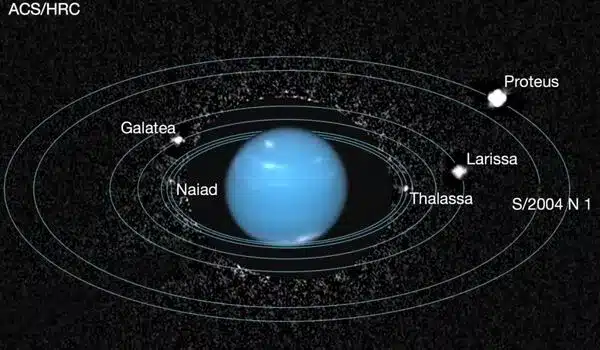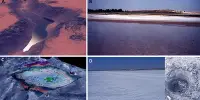The atmosphere of Neptune is notable for its dramatic weather patterns, which include the presence of huge storm systems and dark areas. Clouds on Neptune arise and disappear due to a variety of reasons, including temperature, wind patterns, and the existence of various chemical compounds in the atmosphere, such as methane and ethane. These factors can have an impact on the production and behavior of clouds and storms on Earth.
Astronomers have discovered a relationship between Neptune’s varying cloud abundance and the 11-year solar cycle, which is driven by the waxing and waning of the Sun’s entangled magnetic fields. This discovery is based on three decades of Neptune observations acquired by NASA’s Hubble Space Telescope and Hawaii’s W. M. Keck Observatory, as well as data from California’s Lick Observatory.
Planetary scientists are surprised by the link between Neptune and solar activity because Neptune is our solar system’s farthest major planet and receives sunlight with just about 0.1% of the intensity that Earth does. However, Neptune’s widespread overcast weather appears to be dictated by solar activity rather than the planet’s four seasons, which each span about 40 years.
With the exception of some clouds floating over Neptune’s south pole, cloud coverage on the huge planet is now quite low. A team of astronomers led by the University of California (UC) Berkeley determined that the abundance of clouds normally seen at the icy giant’s mid-latitudes began to diminish in 2019.
Even now, four years later, the most recent images we took this past June still show the clouds haven’t returned to their former levels. This is extremely exciting and unexpected, especially since Neptune’s previous period of low cloud activity was not nearly as dramatic and prolonged.
Erandi Chavez
“I was surprised by how quickly clouds disappeared on Neptune,” said Imke de Pater, senior author of the study and emeritus professor of astronomy at UC Berkeley. “We essentially saw cloud activity drop within a few months,” she went on to say.
“Even now, four years later, the most recent images we took this past June still show the clouds haven’t returned to their former levels,” said Erandi Chavez, a graduate student at the Center for Astrophysics | Harvard-Smithsonian (CfA) in Cambridge, Massachusetts, who led the study when she was an undergraduate astronomy student at UC Berkeley. “This is extremely exciting and unexpected, especially since Neptune’s previous period of low cloud activity was not nearly as dramatic and prolonged.”
Chavez and her colleagues examined Keck Observatory photos from 2002 to 2022, Hubble Space Telescope archival views dating back to 1994, and data from the Lick Observatory in California from 2018 to 2019. Keck observations have been supplemented in recent years by photos from the Twilight Zone program and Hubble’s Outer Planet Atmospheres Legacy (OPAL) mission.
The photographs demonstrate an intriguing correlation between seasonal changes in Neptune’s cloud cover and the solar cycle, which occurs every 11 years and causes the Sun’s magnetic field to grow more twisted like a ball of yarn. This is evidenced by an increase in the number of sunspots and solar flare activity. As the cycle progresses, the Sun’s tempestuous behavior builds to a maximum, until the magnetic field beaks down and reverses polarity. Then the Sun settles back down to a minimum, only to start another cycle.

When it’s stormy weather on the Sun, more intense ultraviolet (UV) radiation floods the solar system. The team found that two years after the solar cycle’s peak, an increasing number of clouds appear on Neptune. The team further found a positive correlation between the number of clouds and the ice giant’s brightness from the sunlight reflecting off it.
“These remarkable data give us the strongest evidence yet that Neptune’s cloud cover correlates with the Sun’s cycle,” said de Pater. “Our findings support the theory that the Sun’s UV rays, when strong enough, may be triggering a photochemical reaction that produces Neptune’s clouds.”
Scientists identified the link between the solar cycle and Neptune’s cloudy weather pattern by examining 2.5 cycles of cloud activity recorded over a 29-year period of Neptunian monitoring. During this time, the planet’s reflectance peaked in 2002 before decreasing in 2007. Neptune brightened again in 2015, then dimmed to the lowest level ever observed in 2020, when most of the clouds vanished.
The variations in Neptune’s brightness induced by the Sun appear to rise and fall in time with the arrival and departure of clouds on the planet. However, there is a two-year lag between the apex of the solar cycle and the amount of clouds seen on Neptune. The chemical changes are caused by photochemistry, which happens high in Neptune’s upper atmosphere and takes time to form clouds.
“It’s fascinating to be able to use telescopes on Earth to study the climate of a world more than 2.5 billion miles away from us,” said Carlos Alvarez, staff astronomer at Keck Observatory and co-author of the study. “Advances in technology and observations have enabled us to constrain Neptune’s atmospheric models, which are key to understanding the correlation between the ice giant’s climate and the solar cycle.”
More effort, however, is required. While an increase in UV sunlight may cause more clouds and haze, it may also darken them, diminishing Neptune’s total brightness. Storms on Neptune that rise up from the deep atmosphere alter cloud cover but are unrelated to photochemically produced clouds, complicating solar cycle correlation studies. Continued Neptune observations are also required to determine how long the current lack of clouds will endure.
The study team is still monitoring Neptune’s cloud activities. “We have seen more clouds in the most recent Keck images that were taken during the same time NASA’s James Webb Space Telescope observed the planet; these clouds were in particular seen at northern latitudes and at high altitudes, as expected from the observed increase in the solar UV flux over the past approximately 2 years,” de Pater said in a statement.















